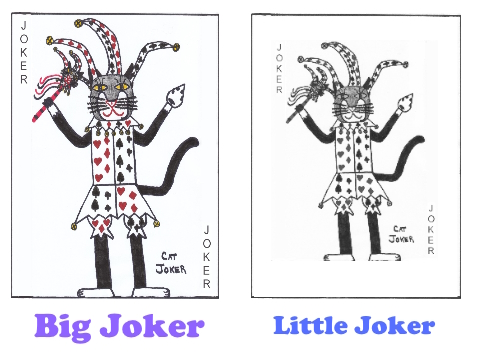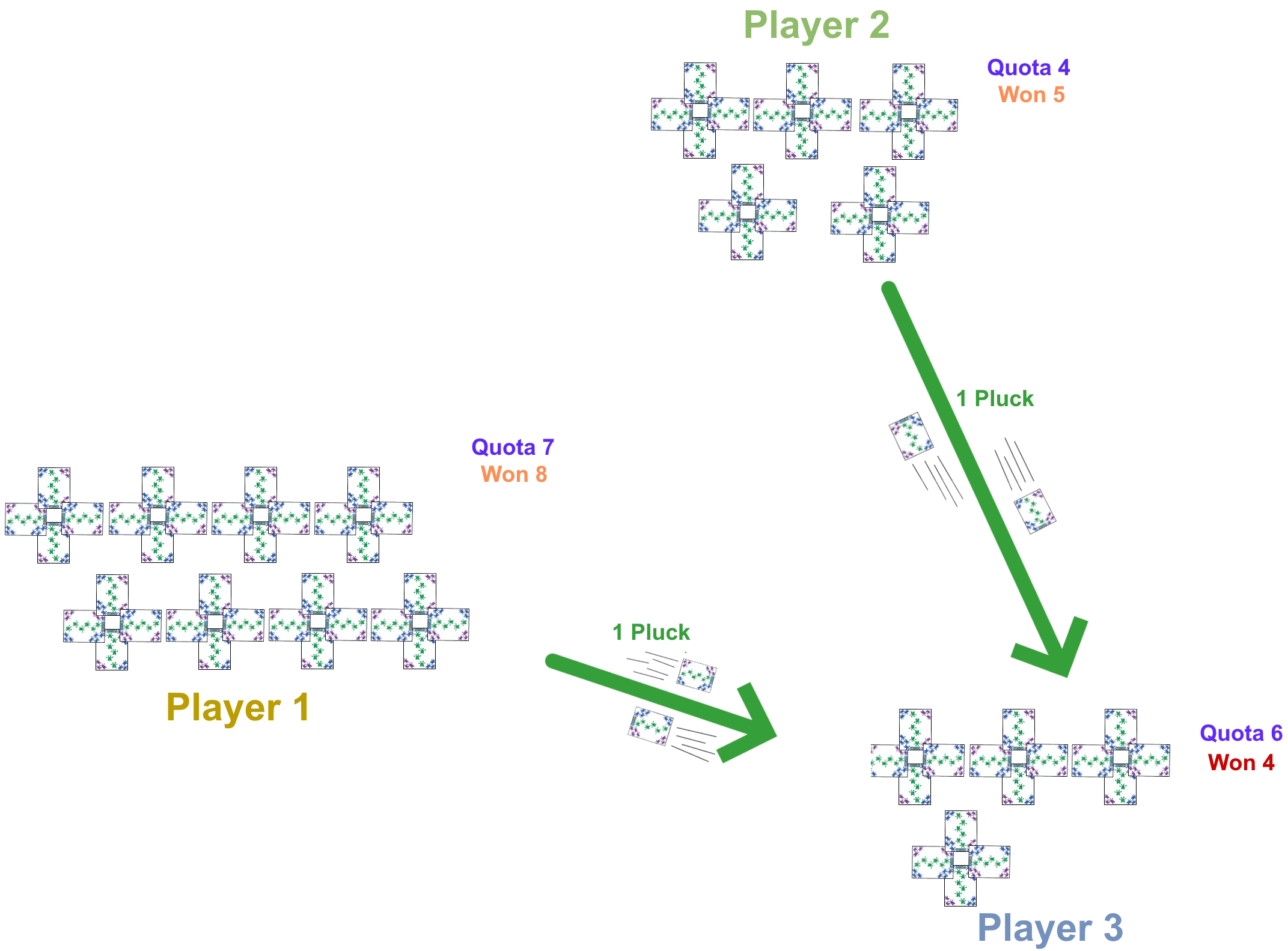 Pluck is played using a slightly modified 52 card deck. To thus create the deck as used for the game, from a normal 52 card deck, the two of hearts, two of diamonds, and two of spades should be removed, leaving only one deuce in the deck, the two of clubs. In addition, two Jokers are then added to this 49 card deck. Each of these Jokers should be distinguishable from each in some manner, such that one Joker is the "Big Joker" and the other the "Little Joker". Most card decks are packaged with two Jokers, one color and one black and white, with the color Joker usually designated as the Big Joker and the black and white Joker set as the Little Joker. The ranking of the cards in the deck as used for this game are as follows (from highest to lowest); Big Joker, Little Joker, Ace, King, Queen, Jack, 10, 9, 8, 7, 6, 5, 4, 3, 2. It should be noted, of course, that only in the suit of clubs will there be a card of denomination two.
Pluck is played using a slightly modified 52 card deck. To thus create the deck as used for the game, from a normal 52 card deck, the two of hearts, two of diamonds, and two of spades should be removed, leaving only one deuce in the deck, the two of clubs. In addition, two Jokers are then added to this 49 card deck. Each of these Jokers should be distinguishable from each in some manner, such that one Joker is the "Big Joker" and the other the "Little Joker". Most card decks are packaged with two Jokers, one color and one black and white, with the color Joker usually designated as the Big Joker and the black and white Joker set as the Little Joker. The ranking of the cards in the deck as used for this game are as follows (from highest to lowest); Big Joker, Little Joker, Ace, King, Queen, Jack, 10, 9, 8, 7, 6, 5, 4, 3, 2. It should be noted, of course, that only in the suit of clubs will there be a card of denomination two.
Determination of seating positions and identity of the first dealer can be performed using a variety of methods, with a draw for high cards a method commonly used. With that method, each player would draw a card from the shuffled deck. If two or more players draw cards of the same denomination, they would set that card aside and draw new, replacement cards. The player drawing the highest card would be set as the first dealer and have the first choice of seats at the table, the player drawing the next highest the next choice of seats and the player drawing the lowest card would take the remaining seat at the table. After each hand, the role of dealer rotates in a clockwise direction around the table.
Once the players are seated, the designated dealer would then thoroughly shuffle the deck and offer it to the player at his right to cut. After the cut, the dealer would then proceed to begin dealing out the entire deck, one card at a time and face-down. He deals the first card to the player at his left and continues dealing, one card at a time in a clockwise direction around the table until each player has 17 total cards.
On each hand, each player has a strict quota as to a number of tricks he is expected to win during that hand. The dealer is required to win seven tricks, the player at his immediate left has a requirement of six tricks, and the player at the dealer's right strives to win four tricks. On the first hand of the game, no "plucking" occurs, but on the second and subsequent hands, dependent on the number of tricks taken by these players, there may be some amount of plucking to occur (see further below for a description of plucking).
After any plucking (if applicable) occurs, the dealer then examines his hand, and based on the cards he finds in it, he may select his choice of trump suits to be used for the hand. He may thus declare any of the four suits to be set as trump for that hand; hearts, clubs, spades, or diamonds. The Jokers are always considered the highest two cards in whichever suit is declared as trump for that hand. Thus, the Jokers are considered full members of the trump suit, and would thus be expected to be played (and have the same restrictions on play) as any other card in the trump suit.
On the first trick of every hand, whichever player has the two of clubs in hand must play this card face-up to the table to start the trick. Each other player in a clockwise rotation then plays one card face-up to the same trick. If a player has a card of the same suit as originally led to the trick, he must play it. However, if he has no cards of the suit led to that trick, he may play a card from any suit, including a member of the trump suit. After each player has played exactly one card to the trick, it is then determined who won that trick.
The highest card in the trump suit (which also includes the Jokers), wins the trick. If no card from the trump suit was played to the trick, the trick is won by the player of the highest card in the same suit as the first card played to the trick. The cards from the trick are set aside and out of play in preparation for the next trick. The winner of each trick leads the first card to the next trick.
Generally, the leader to a trick can play any card of choice from his hand to start the trick. However, as previously noted, on the first trick of the hand, the player with the two of clubs in hand must lead this card. In addition, a player may not lead a card from the trump suit until a card from that suit has previously been played to an existing trick. The exception to this rule, is of course, if clubs is trump, the two of clubs is led to the first trick, and since the suit of clubs has already been led, the leader of subsequent tricks can lead cards of this suit as needed.
 After all seventeen tricks have been played and won, the hand ends and it is then determined which players will obtain plucks from other players. As previously mentioned, each player has a specific quota of tricks that they will attempt to win during the hand. For each trick they win fewer than this number, another player will be entitled to one "pluck" from that player. And for each trick a player wins above his expected quota for that hand, he earns the right to so "pluck" a card from another player. These plucks occur, on every hand after the first, immediately after the deal and before the dealer declares the trump suit to be used for that hand.
After all seventeen tricks have been played and won, the hand ends and it is then determined which players will obtain plucks from other players. As previously mentioned, each player has a specific quota of tricks that they will attempt to win during the hand. For each trick they win fewer than this number, another player will be entitled to one "pluck" from that player. And for each trick a player wins above his expected quota for that hand, he earns the right to so "pluck" a card from another player. These plucks occur, on every hand after the first, immediately after the deal and before the dealer declares the trump suit to be used for that hand.
Thus, each player would then know exactly how many plucks he is entitled to make, or how many plucks other players are entitled to from his hand. As an example, if a player had a quota of 4 tricks, but managed to win 6 he would earn two plucks. If another player, with a quota of 7 tricks won five, other players would be entitled to make two plucks from that player.
The player who is entitled to make the most "plucks" from other players gets to make the first pluck. If two players are entitled to the same number of plucks, the player closest to the dealer (or the dealer if he is one of those players) has the first pluck. To make a pluck a player who is so entitled (called the plucker) picks any card from their hand and passes it face-down across the table to a player who did not win as many tricks as expected (the pluckee). This player then picks up the passed card adding it to his hand. He must then pass back to that player the highest card he has of that same suit. If the passed card would be his highest card, he simply passes the same card back to the plucker. Since, before a trump suit is chosen, the Jokers are considered to not be a member of any suit, a player is never required to pass a Joker to a plucker. If there is just one plucker on a particular hand, he would thus take all his plucks from the appropriate pluckees. A player is never required to allow more plucks from his hand than tricks he was short of his expected quota on that hand, and a player may never take more plucks than tricks he won higher than his quota on that hand. If there are two pluckers, they alternate the turn to pluck amongst them until all the plucks have been completed.
After all plucks have been completed for that hand, the play can then begin for that hand, using the same rules of play as in the first hand of the game.
There is no real concept of scoring in playing three handed Pluck, with hand considered a complete game. However, due to the concept of plucking, the result of each hand can have a drastic effect on the play of next hand. In any game session, however, each player should have the same number of opportunities to take the role of dealer.
 As in the three player version of the game, each team has a specific quota of tricks they are expected to win during the hand. One of the two teams is set as the calling team. On the very first hand of the game, the player who receives the two of clubs is the caller, and he and his partner are thus set as the calling team for that hand. On each subsequent hand, the identity of the caller rotates in a clockwise rotation around the table, from player to player. The calling team on each hand is thus required to attempt to win eight
total tricks during this hand, and the opposing team has a quota total of five.
As in the three player version of the game, each team has a specific quota of tricks they are expected to win during the hand. One of the two teams is set as the calling team. On the very first hand of the game, the player who receives the two of clubs is the caller, and he and his partner are thus set as the calling team for that hand. On each subsequent hand, the identity of the caller rotates in a clockwise rotation around the table, from player to player. The calling team on each hand is thus required to attempt to win eight
total tricks during this hand, and the opposing team has a quota total of five.